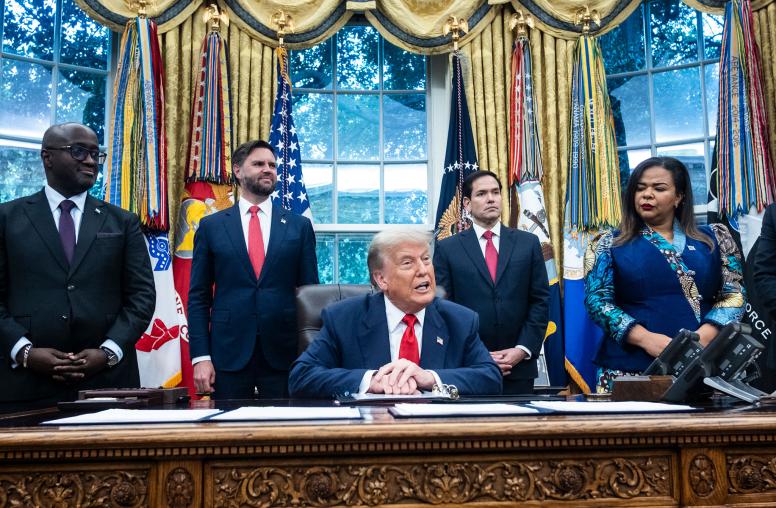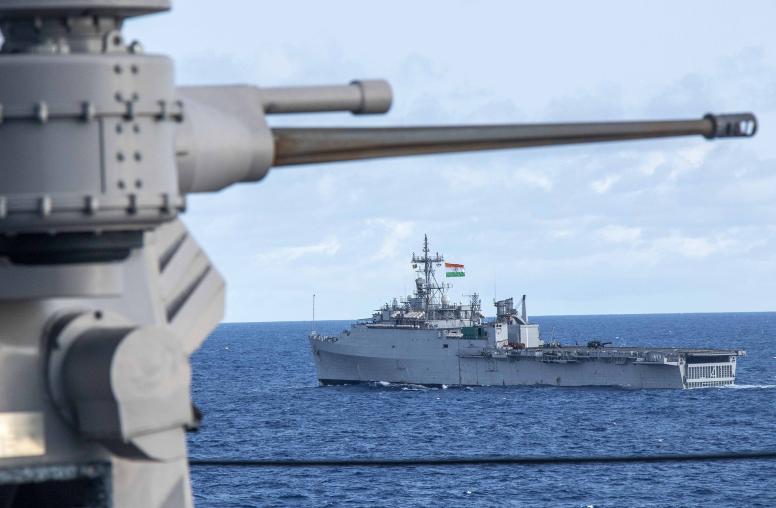William J. Perry and Stephen J. Hadley Testify on the "Quadrennial Defense Review Independent Panel"
William J. Perry and Stephen J. Hadley testified on August 3, 2010 on the "Quadrennial Defense Review Independent Panel" before the Senate Armed Services Committee.

On August 3, 2010, William J. Perry and Stephen J. Hadley testified before the House Armed Services Committee on the "Quadrennial Defense Review (QDR) Independent Panel" which is facilitated by the United States Institute of Peace (USIP). The QDR Independent Panel, which includes 12 appointees of Secretary of Defense Robert Gates and eight appointees of Congress, released a written assessment of the QDR on July 29, 2010.
The following are the co-chairs' prepared remarks:
Chairman Levin and Ranking Member McCain, we thank you for the opportunity to appear before you and other members of this distinguished Committee to discuss the Final Report of the Quadrennial Defense Review (QDR) Independent Panel.
As you know, the QDR Independent Panel includes 12 appointees of the Secretary of Defense, Robert Gates, and 8 appointees of Congress, and is mandated by the National Defense Authorization Act (NDAA) for fiscal year 2010 (FY10) to:
- Review the Secretary of Defense’s terms of reference for the 2009 QDR;
- Conduct an assessment of the assumptions, strategy, findings, and risks in the 2009 QDR;
- Conduct an independent assessment of possible alternative force structures; and
- Review the resource requirements identified in the 2009 QDR and compare those resource requirements with the resources required for the alternative force structures.
That is what our Panel has tried to do in its review. We have deliberated for over five months, in the process reviewing a mass of documents (both classified and unclassified), interviewing dozens of witnesses from the Department, and consulting a number of outside experts. The Congress and Secretary Gates gave us a remarkable set of Panel members who devoted an enormous amount of time and effort to this project. It was a model of decorum and of bipartisan, legislative/executive branch cooperation. Paul Hughes, as Executive Director of the Panel, ably led a talented expert staff. The result is the unanimous report you have before you entitled The QDR in Perspective: Meeting America’s National Security Needs in the 21st Century.
Mr. Chairman, the security challenges facing the United States today are much different than the ones we faced over a decade ago. In addition to ongoing military operations in Iraq and Afghanistan, the United States faces a geopolitical landscape that is increasingly dynamic and significantly more complex. Secretary Gates and the Department of Defense deserve considerable credit for attempting to address all these challenges in the 2009 QDR.
The modern QDR originated in 1990 at the end of the Cold War when Secretary of Defense Dick Cheney and Chairman of the Joint Chiefs of Staff General Colin Powell undertook in the “Base Force” study to reconsider the strategy underpinning the military establishment. Then in 1993, building on his own work as the chairman of the House Armed Services Committee, Secretary of Defense Les Aspin decided to conduct what he called a Bottom-up Review – an examination of the long term risks which America was likely to face, the capabilities necessary to meet them, and the various options for developing those capabilities.
The Bottom-up Review was considered generally a success. Congress thought the process worthwhile and mandated that it be repeated every four years. Unfortunately, once the idea became statutory, it became routine. Instead of unconstrained, long-term analysis by planners who were encouraged to challenge preexisting thinking, the QDRs became explanations and justifications, often with marginal changes, of established decisions and plans.
This latest QDR is a wartime QDR, prepared by a Department that is focused – understandably and appropriately – on responding to the threats America now faces and winning the wars in which America is now engaged. Undoubtedly the QDR is of value in helping Congress review and advance the current vital missions of the Department. But it is not the kind of long term planning document that Congress envisioned when it enacted the QDR requirement.
Our Report is divided into five parts.
It first conducts a brief survey of foreign policy, with special emphasis on the missions that America’s military has been called upon to perform since the fall of the Berlin Wall. From the strategic habits and actual decisions of American presidents since 1945 – habits and decisions that have shown a remarkable degree of bipartisan consistency – we deduce four enduring national interests which will continue to transcend political differences and animate American policy in the future. Those enduring national interests include:
- The defense of the American homeland
- Assured access to the sea, air, space, and cyberspace;
- The preservation of a favorable balance of power across Eurasia that prevents authoritarian domination of that region; and
- Providing for the global “common good” through such actions as humanitarian aid, development assistance, and disaster relief.
We also discuss the five gravest potential threats to those interests that are likely to arise over the next generation. Those threats include, but are not limited to:
- Radical Islamist extremism and the threat of terrorism;
- The rise of new global great powers in Asia;
- Continued struggle for power in the Persian Gulf and the greater Middle East;
- An accelerating global competition for resources; and
- Persistent problems from failed and failing states.
These five key global trends have framed a range of choices for the United States:
- Current trends are likely to place an increased demand on American “hard power” to preserve regional balances; while diplomacy and development have important roles to play, the world’s first-order concerns will continue to be security concerns.
- The various tools of “smart power” – diplomacy, engagement, trade, targeted communications about American ideals and intentions, development of grassroots political and economic institutions – will increasingly be necessary to protect America’s national interests.
- Today’s world offers unique opportunities for international cooperation, but the United States needs to guide continued adaptation of existing international institutions and alliances and to support development of new institutions appropriate to the demands of the 21st century. This will not happen without global confidence in American leadership, its political, economic, and military strength, and steadfast national purpose.
- Finally, America cannot abandon a leadership role in support of its national interests. To do so will simply lead to an increasingly unstable and unfriendly global climate and eventually to conflicts that America cannot ignore, and which we will then have to prosecute with limited choices under unfavorable circumstances – and with stakes that are higher than anyone would like.
In the next two chapters, we turn to the capabilities that our government must develop and sustain in order to protect our enduring interests. We first discuss the civilian elements of national power – what Secretary Gates has called the “tools of soft power.” We make a number of recommendations for the structural and cultural changes in both the Executive and Legislative branches which will be necessary if these elements of national power are to play their role in protecting America’s enduring interests. The Panel notes with extreme concern that our current federal government structures – both executive and legislative, and in particular those related to security – were fashioned in the 1940s and they work at best imperfectly today. The U.S. defense framework adopted after World War II was structured to address the Soviet Union in a bipolar world. The threats of today are much different. A new approach is needed.
We then turn to the condition of America’s military. We note that there is a significant and growing gap between the “force structure” of the military – its size and its inventory of equipment – and the missions it will be called on to perform in the future. As required by Congress, we propose an alternative force structure with emphasis on increasing the size of the Navy. We also review the urgent necessity of recapitalizing and modernizing the weapons and equipment inventory of all the services; we assess the adequacy of the budget with that need in view; and we make recommendations for increasing the Department’s ability to contribute to homeland defense and to deal with asymmetric threats such as cyber attack.
In this third chapter, we also review the military’s personnel policies. We conclude that while the all-volunteer military has been an unqualified success, there are trends that threaten its sustainability. Major changes must be made in personnel management policies and in professional military education. A failure to address the increasing costs of the All Volunteer Force will likely result in: 1) a reduction in force structure; 2) a reduction in benefits; and/or 3) a compromised All Volunteer Force. To avoid these undesirable outcomes, we recommend a number of changes in retention, promotion, compensation, and professional military education that we believe will serve the interests of America’s service members and strengthen the All Volunteer Force.
The fourth chapter of our Report takes on the issue of acquisition reform. We commend Secretary Gates for his emphasis on reducing both the cost of new programs and the time it takes to develop them. But we are concerned that the typical direction of past reforms – increasing the process involved in making procurement decisions – may detract from the clear authority and accountability that alone can reduce cost and increase efficiency. We offer several recommendations in this area.
Finally, our Report’s last chapter deals with the QDR process itself. While we very much approve of the impulse behind the QDR – the desire to step back from the flow of daily events and think creatively about the future – the QDR process as presently constituted is not well suited to the holistic planning process needed by our nation at this time. The United States needs a truly comprehensive National Security Strategic Planning Process that begins at the top and provides the requisite guidance not only to the Department of Defense but to the other departments and agencies of the U.S. government that must work together to address the range of global threats confronting our nation.
The issues raised in our Report are sufficiently serious that we believe an explicit warning is appropriate. The aging of the inventories and equipment used by the services, the decline in the size of the Navy, escalating personnel entitlements, increased overhead and procurement costs, and the growing stress on the force means that a train wreck is coming in the areas of personnel, acquisition, and force structure. In addition, our nation needs to build greater civil operational capacity to deploy civilians alongside our military and to partner with international bodies, the private sector, and non-governmental organizations in dealing with failed and failing states.
The potential consequences for the United States of a “business as usual” attitude towards the concerns expressed in this Report are not acceptable. We are confident that the trend lines can be reversed, but it will require an ongoing, bipartisan concentration of political will in support of decisive action.
In conclusion, we wish to again acknowledge the cooperation of the Department of Defense in the preparation of this Report – and to express our unanimous and undying gratitude to the men and women of America’s military, and their families, whose sacrifice and dedication continue to inspire and humble us.
Mr. Chairman, thank you for the opportunity to testify before you today. We welcome your questions regarding the Final Report of the Quadrennial Defense Review Independent Panel.




